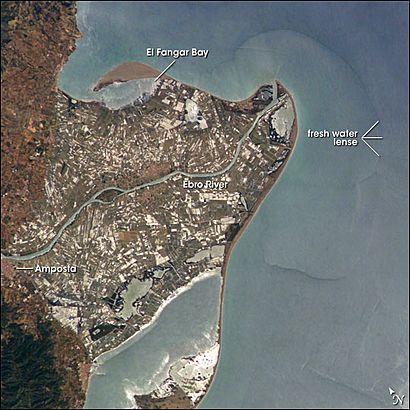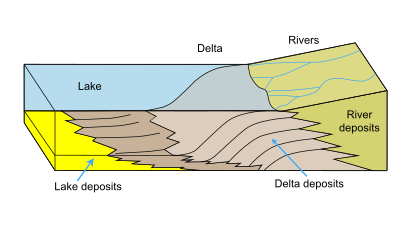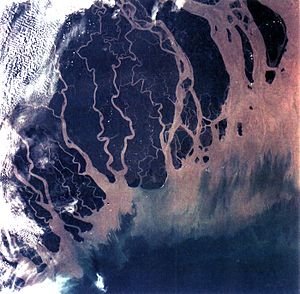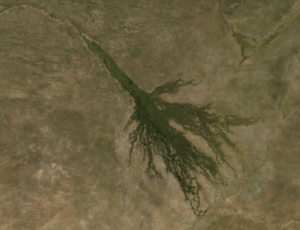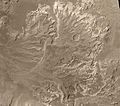River delta facts for kids
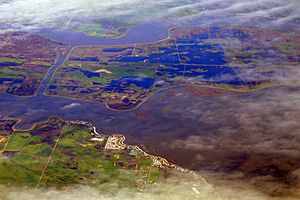
A river delta is a special landform that looks a bit like a triangle. It forms when a river carries a lot of sediment (like sand, mud, and pebbles) and then slows down as it enters a larger body of water. This usually happens when a river flows into an ocean, sea, estuary, lake, or even a reservoir. The name "delta" comes from its triangle shape, which looks like the Greek letter Delta.
River deltas are very important for people. Many large cities and farms are built on them. They help protect the coastline from storms and can be a source of drinking water. Deltas are also important for nature, providing homes for many different plants and animals.
Contents
What Does "Delta" Mean?
The word "delta" comes from the shape of the Nile Delta in Egypt. It looks like the uppercase Greek letter delta, which is a triangle (Δ).
People started using the word "delta" to describe these landforms in English in the late 1700s.
How River Deltas Form
River deltas form when a river carrying sediment reaches a large body of water. This could be a lake, an ocean, or a reservoir. When the river water flows into the still water, it spreads out and slows down a lot.
As the water slows, it can no longer carry all the sediment it was holding. So, the sediment drops to the bottom and starts to pile up. This buildup of sediment creates the river delta. Over time, the river might build new paths, pushing the delta further into the standing water.
Different Kinds of Deltas
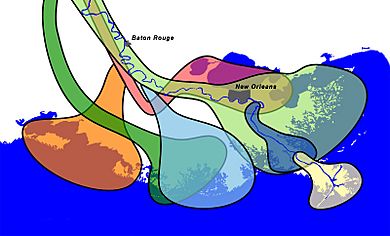
Deltas are often grouped by what mostly controls their shape: the river itself, waves, or tides. The type of sediment the river carries also plays a big part.
River-Controlled Deltas
These deltas form in places where there aren't strong waves or tides. The river's flow and the amount of sediment it carries are the main forces shaping the delta.
The modern Mississippi River Delta is a great example of a river-controlled delta.
Gilbert Deltas
A Gilbert delta is a special type of river-controlled delta. It forms when a river drops coarse sediments, like gravel and large sand, into a lake. Imagine a mountain river flowing into a freshwater lake; it would likely form this kind of delta.
These deltas were first described in 1885 by Grove Karl Gilbert. You can see examples of them in places like Okanagan Lake in British Columbia.
Wave-Controlled Deltas
In these deltas, ocean waves are very powerful and shape the land. Waves can spread the river's sediment along the coast, making the delta look smoother. Sometimes, strong waves can even carry sediment away, causing the delta to shrink.
Tide-Controlled Deltas
Tides also play a big role in shaping some deltas, like the Ganges Delta. In a tide-controlled delta, new river paths (called distributaries) can form during floods or storm surges. These paths slowly fill up with sediment over time.
Tidal Freshwater Deltas
A tidal freshwater delta forms where a river meets an estuary (where fresh and saltwater mix), but in the part where the water is still mostly fresh. These deltas are often affected by human activities like deforestation (cutting down forests) and intensive agriculture. For example, many tidal freshwater deltas in Chesapeake Bay on the east coast of the United States have grown because of sediment from farms and cities.
Estuaries Instead of Deltas
Some rivers, especially those on coasts with very strong tides, don't form a delta at all. Instead, they flow into the sea through an estuary. An estuary is a partly enclosed body of water where fresh river water mixes with salty ocean water. Good examples include the Gulf of Saint Lawrence and the Tagus estuary.
Inland Deltas
Sometimes, a river divides into many branches in an area far from the sea, only to join back together later. This area is called an inland delta. These often form on land that used to be a lake bed. The Okavango Delta in Botswana is a famous example. Here, the river flows into a flat, dry area and its channels spread out and eventually evaporate into the desert.
Other inland deltas include the Inner Niger Delta and parts of the Sacramento–San Joaquin River Delta.
Mega Deltas
"Mega delta" is a term for very large river deltas, especially those found in Asia. These include the Yangtze, Pearl, Mekong, and Ganges-Brahmaputra deltas.
Why Deltas Are Important and What Threatens Them
Deltas are vital places for both nature and people. They are often very fertile, making them excellent for agriculture. Many large cities and industries are built on deltas because they offer flat land, fresh water for drinking and farming, and easy access to the sea for trade.
However, human activities can also harm deltas. When people build dams on rivers upstream, they trap sediment that would normally flow down to the delta. This means less new land is built up. Also, practices like farming methods that prevent soil erosion can reduce sediment delivery.
With less sediment, deltas can start to shrink, especially with sea level rise and natural erosion. The Nile Delta and Colorado River Delta are sad examples of deltas that have been greatly changed by dams and water being used for other purposes.
Deltas are also important for their sand and gravel. These materials are often dug up from old deltas and used to make concrete for roads, buildings, and sidewalks.
Cool Examples of Deltas
- The Ganges–Brahmaputra Delta, mostly in Bangladesh and India, is the largest delta in the world.
- The Selenga River delta in Buryatia, Russia, is the largest delta that flows into a freshwater body, Lake Baikal.
Deltas on Mars
Scientists have found many signs of deltas that formed in ancient lakes on Mars. Finding these deltas is a big clue that Mars once had a lot of water. These Martian deltas have been found in many different places across the planet.
See also
 In Spanish: Delta fluvial para niños
In Spanish: Delta fluvial para niños
- Alluvial fan
- Avulsion (river)
- Estuary
- Levee
- Nile Delta
- Regressive delta


